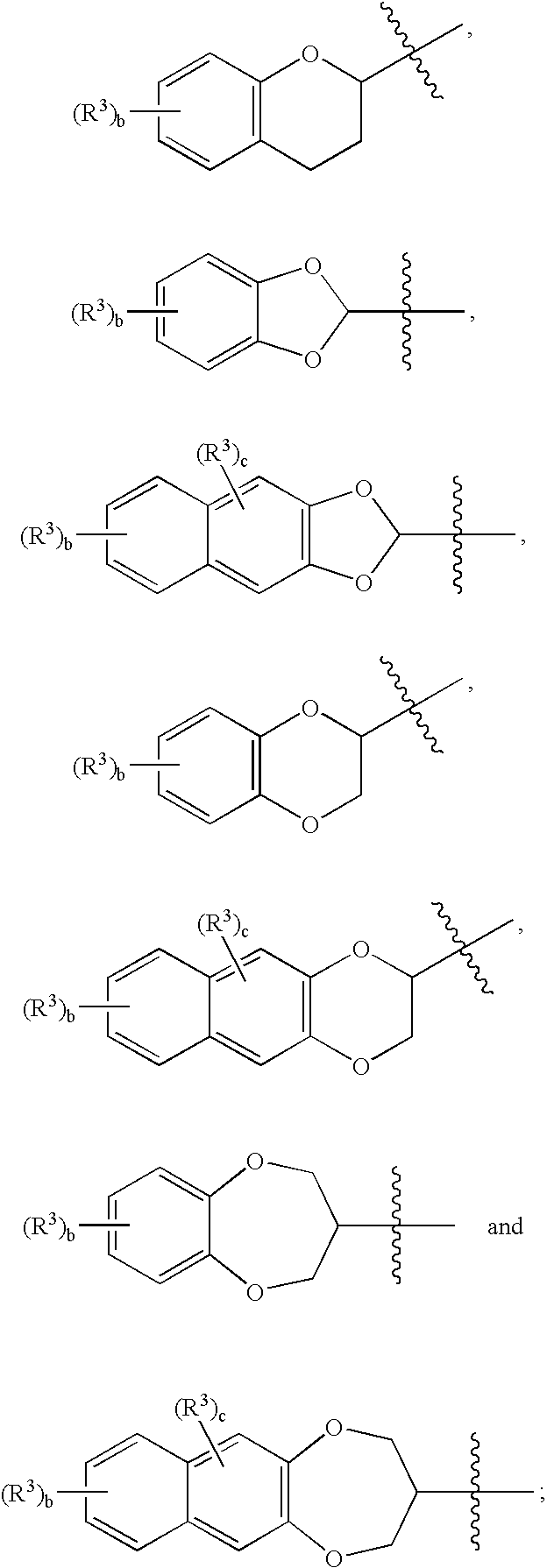Novel sulfamate and sulfamide derivatives useful for the treatment of epilepsy and related disorders
a technology of sulfamate and sulfamide, which is applied in the direction of heterocyclic compound active ingredients, biocide, drug compositions, etc., can solve the problems of systemic antiglaucoma agents such as acetazolamide, which have potentially unwanted side effects, and have stridorous breathing and partial airway obstruction
- Summary
- Abstract
- Description
- Claims
- Application Information
AI Technical Summary
Benefits of technology
Problems solved by technology
Method used
Image
Examples
example 1
((3,4-Dihydro-2H-benzo[b][1,4dioxepin-3-yl)methyl)sulfamide (Compound #3)
[0139]
[0140] Catechol (5.09 g, 46.2 mmol) and potassium carbonate were combined in acetonitrile and heated to reflux for one hour. 2-Chloromethyl-3-chloro-1-propene (5.78 g, 46.2 mmol) was added and the reaction was continued at reflux for 24 hours. The solution was cooled to room temperature and filtered. The filtrate was evaporated and the residue was diluted with water and extracted with diethyl ether (3×). The combined organic solution was dried over MgSO4 and concentrated. Chromatography (2% ethyl ether in hexane) yielded 3-methylene-3,4-dihydro-2H-benzo[b][1,4]dioxepine as a colorless oil.
[0141] MS (ESI): 163.2 (M+H+)
[0142]1H NMR (300 MHz, CDCl3), δ: 6.94 (m, 4H), 5.07 (s, 2H), 4.76 (s, 4H).
[0143] 3-Methylene-3,4-dihydro-2H-benzo[b][1,4]dioxepine (5.00 g, 30.8 mmol) was dissolved in dry THF (100 mL). Borane-THF (1.0 M in THF, 10.3 mL) was added at 0° C. The reaction was stirred at RT for 5 hours. Amin...
example 2
N-(2,3-Dihydro-benzo[1,4]dioxin-2-ylmethyl)-sulfamide (Compound #1)
[0149]
[0150] Racemic 2,3-dihydro-1,4-benzdioxin-2-ylmethylamine (4.4 g, 26 mmol) and sulfamide (5.1 g, 53 mmol) were combined in 1,4 dioxane (100 mL) and refluxed for 2 h. The reaction was cooled to room temperature and a small amount of solid was filtered and discarded. The filtrate was evaporated in vacuo and the residue was purified using flash column chromatography (DCM:Methanol—10:1) to yield a white solid. The solid was recrystallized from DCM to yield the title compound as a white solid.
[0151] mp: 97.5-98.5° C.
[0152] Anal Calc: C, 44.25; H, 4.95; N, 11.47; S, 13.13
[0153] Anal Found: C, 44.28; H, 4.66; N, 11.21; S,13.15
[0154] H1 NMR (DMSO d6) δ 6.85 (m, 4H), 6.68 (bd s, 3H, NH), 4.28 (m, 2H), 3.97 (dd, J=6.9, 11.4 Hz, 1H), 3.20 (m, 1H), 3.10 (m, 1H).
example 3
(Benzo[1,3]dioxol-2-ylmethyl)sulfamide (Compound #2)
[0155]
[0156] Catechol (10.26 g, 93.2 mmol), sodium methoxide (25% by weight in methanol, 40.3 g, 186 mmol), and methyl dichloroacetate (13.3 g, 93.2 mmol) were combined in dry methanol (100 mL). The solution was heated to reflux overnight. The reaction was cooled to room temperature, acidified by addition of concentrated hydrochloric acid and then reduced in volume under vacuum to about 50 mL. Water was added and the mixture was extracted with diethyl ether (3×100 mL). The combined organic solution was dried with MgSO4, concentrated to a brown solid, and chromatographed (2% ethyl acetate in hexane) to yield benzo[1,3]dioxole-2-carboxylic acid methyl ester as a colorless oil.
[0157] MS (ESI): 195.10 (M+H+).
[0158]1H NMR (300 MHz, CDCl3), δ: 6.89 (broad, 4H), 6.29 (s, 1H), 4.34 (q, J=7 Hz, 2H), 1.33 (t, J=7 Hz, 3H).
[0159] To benzo[1,3]dioxole-2-carboxylic acid methyl ester (7.21 g, 40.0 mmol) was added ammonium hydroxide (29% in wa...
PUM
| Property | Measurement | Unit |
|---|---|---|
| Dimensionless property | aaaaa | aaaaa |
| Dimensionless property | aaaaa | aaaaa |
| Dimensionless property | aaaaa | aaaaa |
Abstract
Description
Claims
Application Information
 Login to View More
Login to View More - R&D
- Intellectual Property
- Life Sciences
- Materials
- Tech Scout
- Unparalleled Data Quality
- Higher Quality Content
- 60% Fewer Hallucinations
Browse by: Latest US Patents, China's latest patents, Technical Efficacy Thesaurus, Application Domain, Technology Topic, Popular Technical Reports.
© 2025 PatSnap. All rights reserved.Legal|Privacy policy|Modern Slavery Act Transparency Statement|Sitemap|About US| Contact US: help@patsnap.com



